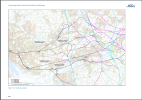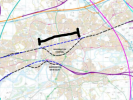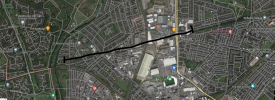Based on that picture, even accounting for NPR, the current route appears to still be the best, unless you want to dramatically increase the budget.
The approach via the M602 doesn't connect to Piccadilly, so you would dramatically reduce connectivity and the approach that still goes to Piccadilly, avoids the airport, which still reduces the connectivity.
So even though "NPR is tacked onto HS2, not designed in tandem" is true, I don't think it significantly changes anything, (Unless you want to dramatically increase the budget of course)
Yes. If there were a direct Handsacre to Manchester Airport routing that was viable in principle, then MSG would have found it back in 2012. There isn't one.
If people are new to this, you can see the original report at
https://www.gov.uk/government/publi...ng-options-report-west-midlands-to-manchester. There's a similar report for the eastern arm. These reports were the first time that specific routes and station options were made public for Phase 2. Over time the routes did get tweaked slightly, e.g. shifting it by a few hundred metres one way or another, or moving it up into viaduct/embankment or down into cuttings or tunnels, but the general principle of the routes stayed the same. The eastern arm did get redone when the Sheffield plan changed, but that was largely it.
For someone to suggest a new route now, they need to be able to explain why it wasn't raised as an option back then. It's not like this report is the final word on high speed rail options, but it does very much narrow down the set of possibilities. The brief was:
The scope of work as set out in remits from HS2 Ltd to MSG for the Manchester leg included consideration of the following core elements:
provision of a route from the tie-in point near Lichfield on the London-West Midlands route to a station within Manchester. The station within Manchester is to have four platform faces, each suitable for a 400 metre long train;
provision of one connection onto the existing West Coast Main Line (WCML) railway;
provision of one infrastructure maintenance depot, ideally to be located towards the centre of the West Midlands to Manchester route; and
provision of one rolling stock depot, ideally to be located towards Manchester.
The scope of work also included the following optional elements:
interchange stations within and on the edge of the Manchester conurbation;
intermediate stations south of the Manchester conurbation;
additional connections onto the existing WCML;
high speed route from the route into Manchester to the north of Preston;
high speed connection to Liverpool; and
‘delta’ connection to allow services from the Manchester city centre station to route to the north onto the West Coast Main Line connection and vice versa
For that penultimate point, they've even produced a map which includes a general indication of a viable high speed route along the M62, plus options for linking the HS2 line onto the various existing classic lines into the city centre.

As far as I understand it, none of the NPR work published since has ever been as detailed as this. With the politics behind it being so uncertain, the government hasn't ever given the green light to spend money actually developing proper options. If we pay civil engineers to do a job, then they will do it.
I think this is the big problem. We need to go back and redo what MSG did but considering the real different requirements that are all in play at the same time:
* London-Manchester services, 400m long and at 3tph, serving the city centre and the Airport/motorway network but running non-stop(-ish) to London.
* London-Liverpool 200m services that will call at Crewe
* London-Scotland 400m services that won't stop below Preston; separate projects further north will reduce journey time to 3 hours.
* London-WCML classic services (Warrington, Wigan, etc)
* Manchester/Liverpool/Scotland-Birmingham services that call at Crewe and possibly other major stations if available.
* Liverpool-Manchester-TransPennine services
* Liverpool/Manchester-Scotland services
* General Manchester rail capacity problems
If you start with HS2 and a Manchester focus then you'll end up with the ever-shrinking Phase 2 west project. If we start by looking at each of these requirements in turn and then working out where they overlap, then we can work out what network we really want to build. It's fine for us to come up with a big menu of improvements that can build upon each other. If we do the sensible work of planning them all together, then we can work out the most efficient way to build them. Maybe we can build certain parts first to deliver a bit more capacity or speed in the short term before the rest of it could be ready.





